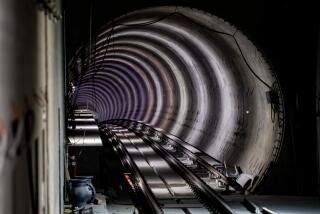Subway Vote Was Right Decision for the Valley : It’s time for MTA to find funding, and critics to move on
The Metropolitan Transportation Authority did the right thing on Wednesday in voting to extend the Red Line across the San Fernando Valley via a separate subway route, and not by an elevated line along the Ventura Freeway.
Years ago in this bitter debate, there had been a time in which engineering factors and other considerations appeared to favor the elevated option. That time has long since passed. It’s also true that the Northridge quake taught us a vital lesson about the fragility of the freeway network we depend upon so heavily. Bridges collapsed, interchanges were closed and entire sections of roadway were destroyed.
As we have stated before, the Southern California transportation system must become less dependent on freeways and it must offer more options. What if the next major quake damages the Ventura Freeway in the way that the Northridge temblor affected the Golden State, Santa Monica and Simi Valley freeways? You remember the traffic jams, confusing alternative routes, the hours added to commute times.
Running the Red Line across the Valley along Burbank and Chandler boulevards provides another east-west transportation corridor. It increases the chances for survivability of one of those routes in the event of another big quake.
For that and many other reasons, Mayor Richard Riordan said that the MTA’s 8-5 vote in favor of the subway was “clearly the right decision.” So did County Supervisor Ed Edelman, who added that the decision represented “a great day for the Valley.” Also on board was an overwhelming majority of the Los Angeles City Council and the city’s transportation department.
Why? Consider the following:
* By most estimates, the cost advantage of the freeway route had evaporated, and $159 million has already been spent on obtaining rights of way for the subway route.
* According to city transportation officials, the subway route can be more easily integrated with existing bus lines.
* Building the subway will involve less traffic congestion.
* It will be easier to construct, segment by segment, should funding problems arise.
* Passengers will have a seamless ride from Canoga Park to Downtown.
* The subway route will serve more heavily populated areas than the freeway route.
* The subway route enjoys the support of most homeowner associations and civic groups in the Valley.
Yes, the MTA has been embarrassed by tunneling problems and a cutoff of federal funding. But the MTA is doing the right things to rectify the damage, particularly in dissolving the Rail Construction Corp., which has overseen subway construction.
Now, it’s up to the MTA to move smartly forward with the kind of thorough and convincing environmental studies that will secure federal funding for the project. It’s also time for the MTA to continue to make the kind of management changes that will ensure that future subway tunnels will be properly built, on time and on budget. And it’s time for the opponents of the subway route to finally admit defeat, and move on.
More to Read
Sign up for Essential California
The most important California stories and recommendations in your inbox every morning.
You may occasionally receive promotional content from the Los Angeles Times.










